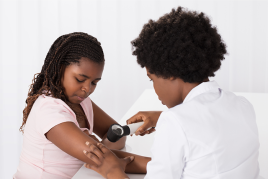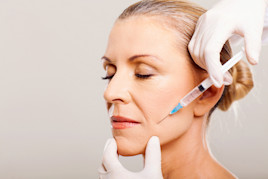Skin cancer types: Sebaceous carcinoma signs & symptoms
Signs and symptoms: On the eyelid
Many sebaceous carcinomas (SC) develop on an eyelid. When this rare skin cancer develops on an eyelid, the person may notice one or more the following:
Slowly growing, often yellowish lump on the eyelid that feels firm, deep, and painless.
Thickening of an eyelid, where lid meets lash.
Yellow or reddish crust on eyelid, where lid meets lash.
Growth on eyelid that looks like a pimple.
Growth on eyelid that bleeds.
Sore on eyelid that does not heal, or heals and reappears.
As the cancer progresses, it often looks like the person has pink eye. You may see growths on the upper and lower eyelid. The growths may open and ooze fluid. The eyelashes often fall out. As the cancer spreads, it can affect the eyesight.
Two patients diagnosed with sebaceous carcinoma
What you see may be barely noticeable (C) or obvious (D).

Mistaken identity: Stye, chalazion, or pink eye
SC is rare. Other growths that develop on the eyelid are much more common. Sometimes, SC is mistaken for one of these eye conditions:
Stye: This is a common growth, which often looks like a pimple on the eyelid. Most styes feel tender when touched. SC tends to be painless. Without treatment, a stye can make blinking painful. The eyelid can swell, and the eyes may water.
Most styes clear with treatment, which usually involves applying a warm compress 4 to 6 times a day.
Chalazion: This common eye condition often causes an eyelid to swell. Most chalazions clear with treatment, which often requires the patient to apply warm compresses to the eye and use antibiotic eye drops.
Pink eye: Also called conjunctivitis, SC can look like pink eye that just won’t go away — even with treatment.
Signs and symptoms: Beyond the eyelid
Few people have been diagnosed with SC elsewhere on the body. When SC develops elsewhere, it usually appears on the head or neck. SC has also been diagnosed on the genitals, ear canal, breasts, and trunk (chest, back, abdomen, buttocks) of the body.
In these areas, SC may look like a slowly growing pink or yellowish lump. This lump may bleed. If you see any of the following for more than 2 weeks, you should immediately make an appointment to see a dermatologist:
New growth on your skin, eyelid, or inside your ear.
A mole or other spot that starts to change.
Any growth or spot that starts to bleed, grow, or change in any way.
Images
References
Harwood CA, McGregor JM, Swale VJ,et al.“High frequency and diversity of cutaneous appendageal tumors in organ transplant recipients.” J Am Acad Dermatol. 2003 48:401-8.
Nelson BR, Hamlet KR, Gillard M et al. “Sebaceous carcinoma.” J Am Acad Dermatol. 1995; 33:1-15; quiz 6-8.
Spencer JM, Nossa R, Tse DT et al. “Sebaceous carcinoma of the eyelid treated with Mohs micrographic surgery.” J Am Acad Dermatol. 2001;44:1004-9.
Torres JS,. Amorim AC, Hercules FM et al. “Giant extraocular sebaceous carcinoma: case report and a brief review of a literature.” Dermatol Online J. 2012 Nov 15;18(11):7.)
 Molluscum contagiosum: How to safely treat it
Molluscum contagiosum: How to safely treat it
 Biosimilars: 14 FAQs
Biosimilars: 14 FAQs
 Practice Safe Sun
Practice Safe Sun
 Relieve uncontrollably itchy skin
Relieve uncontrollably itchy skin
 Fade dark spots
Fade dark spots
 Untreatable razor bumps or acne?
Untreatable razor bumps or acne?
 Laser hair removal
Laser hair removal
 Scar treatment
Scar treatment
 Botox
Botox
 Free materials to help raise skin cancer awareness
Free materials to help raise skin cancer awareness
 Dermatologist-approved lesson plans, activities you can use
Dermatologist-approved lesson plans, activities you can use
 Find a Dermatologist
Find a Dermatologist
 What is a dermatologist?
What is a dermatologist?